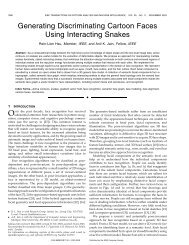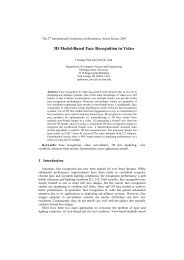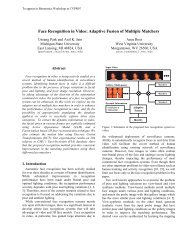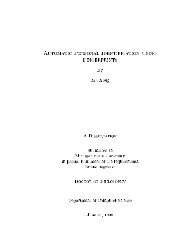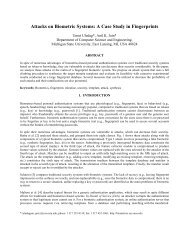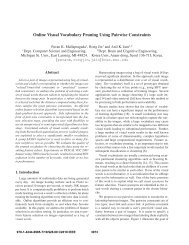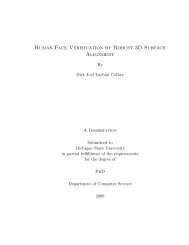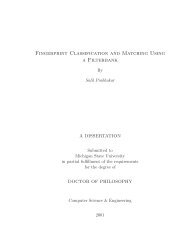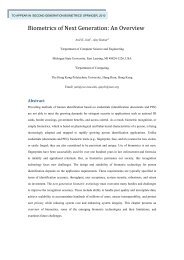Face Detection and Modeling for Recognition - Biometrics Research ...
Face Detection and Modeling for Recognition - Biometrics Research ...
Face Detection and Modeling for Recognition - Biometrics Research ...
Create successful ePaper yourself
Turn your PDF publications into a flip-book with our unique Google optimized e-Paper software.
where Map(x, y) is either the eye or the mouth map; the parameter α is equal to<br />
0.5 <strong>for</strong> the initial threshold value, <strong>and</strong> is equal to 0.8 <strong>for</strong> the stopping threshold.<br />
The use of upper bounds on the number of eye <strong>and</strong> mouth c<strong>and</strong>idates can prevent<br />
the algorithm from spending too much time in searching <strong>for</strong> facial features. In our<br />
implementation, the maximum number of eye c<strong>and</strong>idates, N eye , is 8 <strong>and</strong> the maximum<br />
number of mouth c<strong>and</strong>idates, N mth , is 5.<br />
3.3.4 <strong>Face</strong> Boundary Map<br />
Based on the locations of eyes/mouth c<strong>and</strong>idates, our algorithm first verifies whether<br />
the average orientation of luma gradients around each eye matches the interocular<br />
direction, <strong>and</strong> then constructs a face boundary map from the luma. Finally, it utilizes<br />
the Hough trans<strong>for</strong>m to extract the best-fitting ellipse. The fitted ellipse is used <strong>for</strong><br />
computing the eye-mouth triangle weight. Figure 3.12 shows the boundary map that<br />
is constructed from both the magnitude <strong>and</strong> the orientation components of the luma<br />
gradient within the regions that have positive orientations of the gradient orientations<br />
(i.e., have counterclock-wise gradient orientations). We have modified Canny edge<br />
detection [170] algorithm to compute the gradient of the luma as follows. The gradient<br />
of a luma subimage, S(x, y), which is slightly larger than the face c<strong>and</strong>idate in size<br />
is estimated by<br />
∇S(x, y) = (G x , G y ) = (D σ (x) ⊛ S(x, y), D σ (y) ⊛ S(x, y)), (3.13)<br />
76



